
The Curculionidae are a family of weevils, commonly called snout beetles or true weevils. They are one of the largest animal families with 6,800 genera and 83,000 species described worldwide. They are the sister group to the family Brentidae.
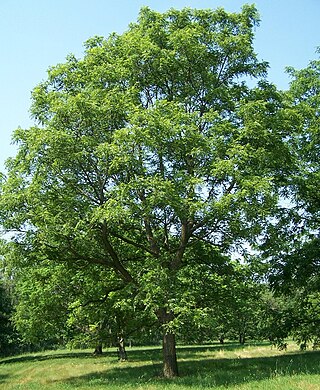
Walnut trees are any species of tree in the plant genus Juglans, the type genus of the family Juglandaceae, the seeds of which are referred to as walnuts. All species are deciduous trees, 10–40 metres (33–131 ft) tall, with pinnate leaves 200–900 millimetres (7.9–35.4 in), with 5–25 leaflets; the shoots have chambered pith, a character shared with the wingnuts (Pterocarya), but not the hickories (Carya) in the same family.
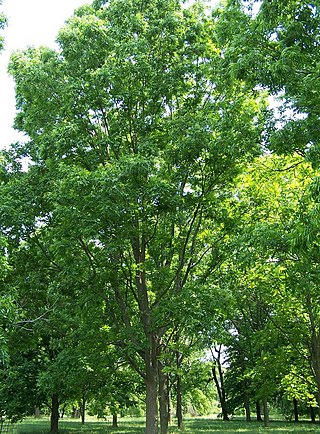
The pecan is a species of hickory native to the southern United States and northern Mexico in the region of the Mississippi River.

Hickory is a common name for trees composing the genus Carya, which includes around 18 species. Five or six species are native to China, Indochina, and India (Assam), as many as twelve are native to the United States, four are found in Mexico, and two to four are native to Canada. A number of hickory species are used for their edible nuts, lumber or other wood and woodcraft products.
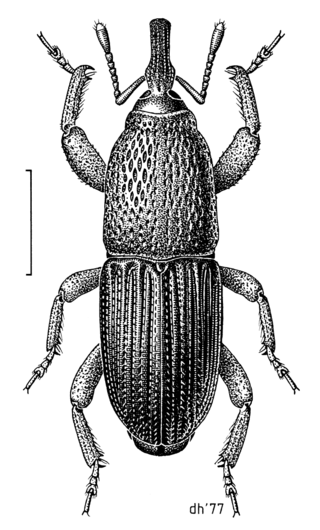
The wheat weevil, also known as the grain weevil or granary weevil, is an insect that feeds on cereal grains, and is a common pest in many places. It can cause significant damage to harvested stored grains and may drastically decrease crop yields. The females lay many eggs and the larvae eat the inside of the grain kernels.

Citheronia regalis, the regal moth or royal walnut moth, is a North American moth in the family Saturniidae. The caterpillars are called hickory horned devils. The adult (imago) has a wingspan of 3.75–6.1 in (9.5–15.5 cm). The species was first described by Johan Christian Fabricius in 1793.
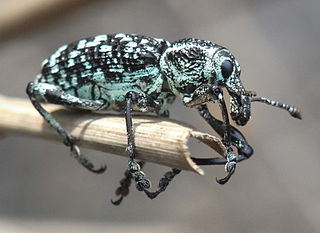
Chrysolopus spectabilis is a species of weevil found in south-eastern Australia. It was discovered during James Cook's first voyage, and became one of the first insects to be described from Australia. The weevil measures up to 25 mm (1.0 in) long and includes distinctive metallic green and black scales. It is found only on 28 species of the plant genus Acacia.

Curculio is a genus of weevils belonging the family Curculionidae and subfamily Curculioninae. Members of the genus are commonly referred to as acorn weevils or nut weevils as they infest the seeds of trees such as oaks and hickories. The adult female weevil bores a tiny hole in the immature nut to lay her eggs, which then hatch into legless grubs. In autumn, the grubs bore holes through the shells from the inside to emerge into the soil where they may live for a year or two before maturing into adults.

Curculio nucum, the nut weevil, is a medium-sized beetle, with an especially elongated snout, characteristic of the Curculionini tribe of the weevil family (Curculionidae). Its larvae develop in hazel nuts Corylus avellana, being a serious pest in hazelnut orchards. It occurs in most of Europe, from south Sweden, Finland and Great Britain to the Mediterranean.

Carya laciniosa, the shellbark hickory, in the Juglandaceae or walnut family is also called kingnut, big, bottom, thick, or western shellbark, attesting to some of its characteristics. It is a slow-growing, long-lived tree, hard to transplant because of its long taproot, and subject to insect damage. The nuts, largest of all hickory nuts, are sweet and edible. Wildlife and people harvest most of them; those remaining produce seedling trees readily. The wood is hard, heavy, strong, and very flexible, making it a favored wood for tool handles. A specimen tree has been reported in Missouri with 117 cm (46 in) diameter at breast height, 36.9 m tall, and a spread of 22.6 m.

Acrobasis nuxvorella, the pecan nut casebearer, is a moth of the family Pyralidae described by Herbert H. Neunzig in 1970. It is found in the United States in eastern New Mexico, Texas, Oklahoma, Louisiana, Missouri, southern Illinois, Mississippi, Alabama, Florida, Georgia, South Carolina and North Carolina.
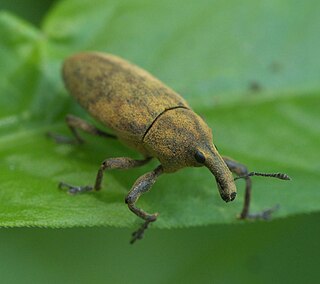
Lixus concavus, commonly called the rhubarb curculio, is a species of weevil. Rhubarb is a host, together with dock, sunflower, and thistle.

The maize weevil, known in the United States as the greater rice weevil, is a species of beetle in the family Curculionidae. It can be found in numerous tropical areas around the world, and in the United States, and is a major pest of maize. This species attacks both standing crops and stored cereal products, including wheat, rice, sorghum, oats, barley, rye, buckwheat, peas, and cottonseed. The maize weevil also infests other types of stored, processed cereal products such as pasta, cassava, and various coarse, milled grains. It has even been known to attack fruit while in storage, such as apples.

Hylobius transversovittatus is a species of weevil in the family Curculionidae. It is native to the Old World where both adults and larvae feed on purple loosestrife. This plant is regarded as an invasive species in North America and the weevil has been introduced into both the United States and Canada in an effort to control the plant.

Curculio elephas is a species of beetle in the family Curculionidae, the true weevils. It is known commonly as the chestnut weevil. It is a serious pest of chestnut in Europe.

Hypera nigrirostris, commonly known as the lesser clover leaf weevil, is a species of weevil that is native to Europe and northern Africa and has been introduced to North America and Japan. Both adults and larvae feed on red clover and other plants in the family Fabaceae.

Ceutorhynchus obstrictus, the cabbage seedpod weevil, is a species of snout beetles or true weevils which is widespread in Europe and lives on several types of crucifers. The adult weevils feed on the leaves, but breed in the seedpods, where the larvae destroy the seeds. It can be a harmful pest on crops like rapeseed/canola, cabbage and relatives or Brassica rapa.

Sphenophorus parvulus, commonly known as the bluegrass billbug, is a species of beetle in the family Curculionidae. It is found in North America, especially in the eastern United States. It is a pest of Kentucky bluegrass, other grasses, corn and grain crops.

Curculio sayi, the small or lesser chestnut weevil, is a species of true weevil in the family of beetles known as Curculionidae.
Cylindrocopturus adspersus, the sunflower stem weevil, is a species of true weevil in the beetle family Curculionidae. It is found in North America, where the larvae tunnel in the stems of wild and cultivated sunflower plants.



















